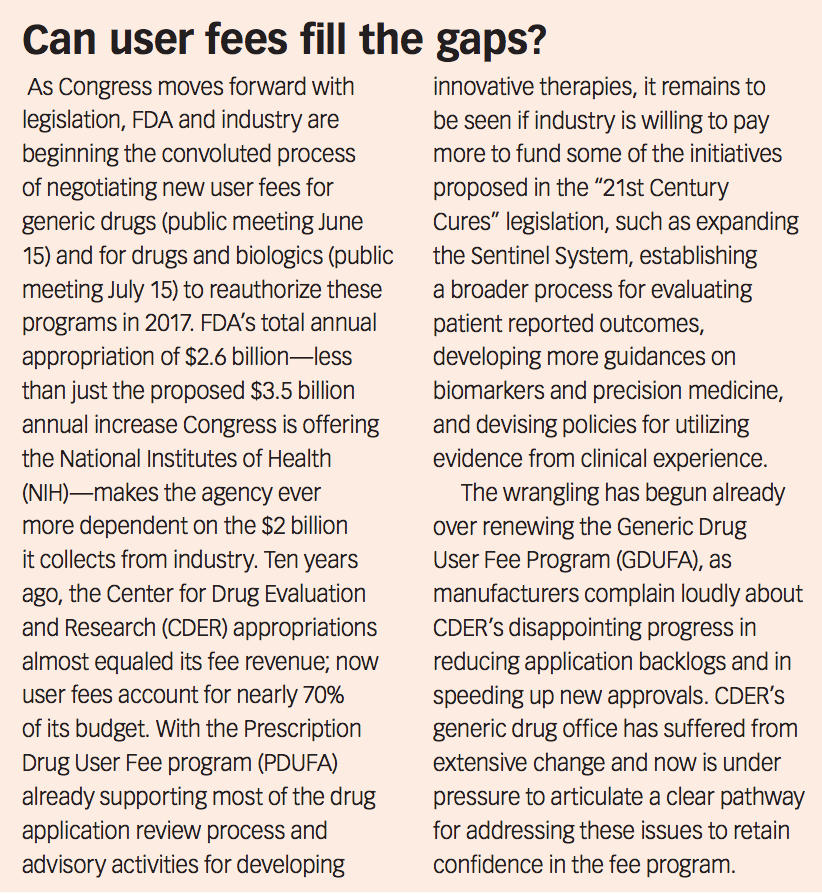More Mandates for FDA
Pharmaceutical Executive
New proposals from Congress to spur innovation will strain resources needed for regulatory approval.
With a bipartisan “21st Century Cures” bill moving through Congress, and negotiations beginning on how the next round of user fees will shape FDA policies and priorities (see sidebar), there’s great optimism in Washington that these efforts will yield real improvements in biomedical discovery and drug development to speed new therapies to patients. FDA officials, though, are nervous about finding resources to implement new
Jill Wechsler

mandates while maintaining an efficient review process.
Despite broad support for the “Cures” bill negotiated by leaders of the House Energy & Commerce (E&C) Committee, there may be a long wait for Senate action. E&C chairman Fred Upton (R-Mich) is looking for final House approval this summer, but members of the Senate Health, Education, Labor and Pensions (HELP) Committee are crafting their own innovation legislation and don’t expect a bill until fall.
The House measure gained Democratic support by offering a hefty budget increase for the National Institutes of Health (NIH) and under pressure, agreed later to add a sizeable funding increase for FDA. The measure proposes to boost NIH funding by $5 billion over three years (to hit $35 billion in 2018) and provides another $10 billion over five years to support a new NIH Innovation Fund. FDA is authorized less than $100 million a year to support clinical trial modernization and evidence development. More important, added language exempts FDA user fees from budget sequestration and proposes “pay for” options. But despite a groundswell in support for greater government funding for biomedical research, there’s no indication that Congressional appropriators will provide any new money for NIH or FDA.
Meanwhile, Janet Woodcock, director of the Center for Drug Evaluation and Research (CDER), fears that a law requiring new programs and multiple guidances will undermine her ability to meet review and approval commitments. This latest E&C proposal has “significant resource implications for FDA,” Woodcock stated at an April E&C health subcommittee hearing. CDER’s new drug review process is now “going at full speed, and we’d like to keep it that way,” she commented, warning that timely sponsor meetings important for accelerating innovative development programs “would be the first to go” if the agency gets further stretched on resources.
FDA’s first priority is to implement statutory requirements set by Congress, she explained. Next comes meeting user fee goals negotiated with industry. The extensive resources needed to advise on clinical programs and to collaborate on biomarkers might have to be scaled back.
Help on hiring
What FDA sorely needs, says Woodcock and others, is to cut some of the red tape and obstacles to recruiting and retaining experts able to address complex scientific and regulatory issues. Too-low salaries prompt experienced staffers to leave for more rewarding jobs in industry and academia, and complex government employment practices make it hard to attract top talent. Woodcock told the Senate HELP Committee that staff turnover “is a huge problem for us” and that FDA has “a desperate time” bringing in neurologists due to low salaries.
Jeffrey Shuren, director of the Center for Devices and Radiological Health (CDRH), similarly described FDA as the “training ground for industry,” as young professionals leave after a few years for industry jobs offering salaries two or three times what they make at FDA, and where the work load is more manageable. When medical reviewers depart right in the middle of processing an application, Shuren added, that ultimately hurts patients as well as regulated companies.
The “Cures” legislation would help FDA by raising some pay rates and making it slightly easier to employ certain specialists. Woodcock also would like new hires from biopharma companies to be able to place securities in blind trusts instead of having to sell them to come to FDA. And she sought more “direct hire authority” to speed up the employment process for certain health professionals able to “go toe-to-toe with industry scientists.”
Seeking agreement
To gain Democratic support for the Cures initiative, Republicans agreed to the NIH budget increase and dropped some controversial provisions, such as extended exclusivity on certain new medical products. But there is agreement to reauthorize the priority review voucher program for rare pediatric diseases, which is set to expire, as well as an initiative to spur development of new antibiotics, utilizing a modified approval pathway for therapies targeted to limited populations. The legislation encourages more sharing of research and clinical data by removing barriers to national interoperability of e-health records. And there’s support for telemedicine, for faster coverage decisions on new vaccines, and for a breakthrough program for medical devices.
Under the heading of achieving a “faster, safer and more personalized” research system, the “Cures” bill backs greater use of central, or “lead,” institutional review boards (IRBs)

to oversee multi-site studies, authorizes greater use of “clinical experience” reports to help support FDA approval of certain new indications, and gives FDA flexibility to approve “qualified indications” based on clinical data summaries, as opposed to full case reports.
Payers as well as pharma companies support flexibility in presenting healthcare economic information to formulary committees and insurers, a change likely to increase industry investment in economic analysis, according to a report by Avalere Health. And a “medical education” provision would revise the “Sunshine” disclosure program to make it easier for marketers to distribute journal articles and medical textbooks to physicians and to support certain continuing medical education events.
Even though FDA already is doing much to accelerate biomarker qualification, the process could benefit from Congressional backing, says former FDA commissioner Andrew von Eschenbach. He emphasized at a recent Alliance for Health Reform briefing that biomarker assessment is key to furthering precision medicine and predicted that Congress will pass “transformational legislation” this year; just how big the bill will be, he added, is “a work in progress.”
Jill Wechsler is Pharmaceutical Executive's Washington correspondent. She can be reached at jwechsler@advanstar.com
Have your say: leave a comment below

FDA Approves Opdivo Plus Yervoy Regimen for MSI-H/dMMR Colorectal Cancer
April 9th 2025Approval of the Opdivo plus Yervoy combination regimen was based on results from the Phase III CheckMate-8HW trial, which was the largest immunotherapy study in patients with previously untreated, unresectable, or metastatic microsatellite instability-high or mismatch repair deficient colorectal cancer.
Navigating Distrust: Pharma in the Age of Social Media
February 18th 2025Ian Baer, Founder and CEO of Sooth, discusses how the growing distrust in social media will impact industry marketing strategies and the relationships between pharmaceutical companies and the patients they aim to serve. He also explains dark social, how to combat misinformation, closing the trust gap, and more.